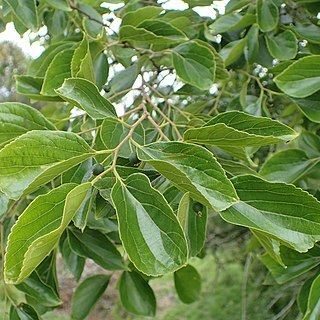Trees, to 18 m tall, deciduous. Bark gray. Branchlets yellowish brown, brown with age, densely pubescent when young, with scattered lenticels. Winter buds blackish brown, 3-5 mm, densely strigose; scales at least inner ones hispid with appressed parallel hairs. Stipules linear-lanceolate, pubescent, caducous. Petiole 3-6 mm, pubescent when young, adaxially with a broad and shallow furrow; leaf blade broadly ovate, ovate, or ovate-elliptic, 2.5-8 × 2-4 cm, thinly coriaceous, strigose or sericeous early in season, with inconspicuous scattered appressed hairs, often glabrescent except for major veins and abaxial vein axils, base obtuse to ± rounded and slightly oblique, margin shallowly serrate on apical half, teeth (0-)6-11(-14) on each side, apex slenderly acuminate to caudate-acuminate; secondary veins 2(or 3) on each side of midvein. Style branches linear, undivided. Infructescences 1-3 per leaf axil, slender, unbranched, pubescent, 1-2 cm, 2-5 × as long as subtending petiole. Drupe yellow to reddish orange, ± globose, 5-7 mm. Stones slightly compressed, ca. 4 mm in diam., reticulately foveolate, 4-ribbed. Fl. Apr-May, fr. Sep-Oct.
More
A shrub or tree. It loses its leaves during the year. It grows 14 m tall. The branches have a reddish-brown covering. The leaves are narrowly oval and 4-10 cm long by 2-5 cm wide. The base is an oblique wedge shape. There can be teeth towards the tip. The flowers have several united. There are 2 or 3 fruit. These are fleshy, oval and 6 mm across. They are on stalks 1-1.5 cm long.


